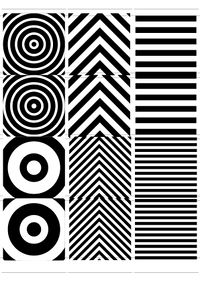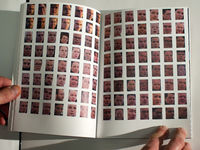Andreas methods 10-04-19: Difference between revisions
| Line 34: | Line 34: | ||
'''3) Reducing the set''' | '''3) Reducing the set''' | ||
Starting point for this exercise was the [https://archive.org/details/communications_primer Communications Primer from Charles & Ray Eames]. | |||
For my film for the eye I set myself a few parameters: | For my film for the eye I set myself a few parameters: | ||
Revision as of 12:31, 10 April 2019
Word count 1500 max.
What have you been making?
In my work I want to explore „brevitas“ in the moving image and bring into a series of semiotics. From ancient times to the modern era the rhetoric has been the binding and constant guideline of communication. Nowadays there is less new in the rhetoric, even though the complexity of content has increased. Also, there seems to be a dominance of the visual in the „screen-“ or „display culture“. The term of „brevitas“ has been explored extensively in verbal/written communication. Also in product design, architecture (baroque vs minimalist design) or visual communication there has been big research on the topic of reduction vs excess.
How did you do it? (method)
„How is the image becoming its sense?“ Roland Barthes is asking in his essay „Rhetorik des Bildes“. And further: „Where does this sense end? And if it ends, what is beyond this end?“ (Barthes 1964, p. 159). Basis of this structural analyses is the thought, that even non-spoken information is inheriting speech-analogue structures. That means that pictures can be statements. That is when they have their own rhetoric and it is even more the case for combination of picture and text. Barthes discovers in, „nature“ and „history“ always being confused with each other, a „ideological misuse“ (ebd. p. 7). Who wants to get to the bottom of these things, has to understand that in our culture and our society nothing has to be as it is right now. Everything could also be different. And in many respects it is desirable for it to being different. The production of visual mythologies can prevent from thinking about that. If the world is, as it is, and will stay like that forever; if the signs are assigned to the things by nature, then it is not necessary to think critically about the order of things and signs.
Before heading over to the moving image I wanted to get the basics straight and therefore started out with various smaller experiments that related to photography:
1) Maximise – Minimize
Building my own camera within the focal camera workshop enabled me to create images similar to the lenticular method. What would happen if I bring in two subjects into one image? Since I already explored double exposures before my studies I wanted to try this out with a shaped mask behind the photo paper.
I lasercut a stripe-shaped mask that would be placed in front of the Negative. This shape would be movable between to positions. After exposing the first half I would move the striped shape to the second position and expose the missing parts of the negative.
2) Reduction through cropping an image
Together with Susanna Fasciolo I made a photo series called “Frown”, depicting portraits of cyclists and people who ride their scooters over the Erasmusbridge. The book consists of cropped images showing faces. At first, the actual topic is not being revealed. You can only see the cropped faces in a grid of 7 x 8 photos per page. Every page consists of two pages (similar to the japanese binding) that are folded, perforated and can – ultimately – be opened on the perforation. The reader is forced to make assumptions on where these photos could have been taken. Have all these people been in one big crowd? Are they at a demonstration? Only by opening the perforation on each page one can find out more about the scene.
3) Reducing the set
Starting point for this exercise was the Communications Primer from Charles & Ray Eames. For my film for the eye I set myself a few parameters:
- Reduction to a single room/hallway.
- Reducing the colours to black and white.
Therefore the actress had to convey all the emotion through her mimics and gestures. The only support that was given by the post-production was the score as well as the editing/rhythm of the cuts.
On the other hand it is the task of communication designers to contain the fundamental ambiguity of isolated text or imagery to a specific purpose. This is a specific form of communicative rationality, a visual economy, that – because of it being created for that purpose – is radically varying from the practice arts. According to Thomas Friedrich, this containment of ambiguity does not necessarily have to lead to unambiguousness. Communication can be designed the way, that it can be read in various styles. This ambiguity should not be dysfunctional in terms of communicative purpose. One would have to differentiate functional from dysfunctional ambiguity. Only the last should be avoided – and the communicative practice is showing, that it is not always easy, because unintentional connotations can occur.
Relation to previous practice
Identify developing practices and theoretical approaches over the last year. This can be very practical: new working methods, new skills &c; describe what such new skills afford.
What do you want to make next?
How does your proposed future research connect to previous projects you have done? Here you can use the descriptions you made during the Methods seminar or make new descriptions.
Why do you want to make it?
This exercise is trying to find the „modest“ or „appropriate“ amount of communication. It shall remove decoration, accessories and digression or even add all these redundancies to find the essence. How is simplification or excess changing the visual appearance of content? From which point of the reduction or maximisation of content is distorting the content itself? On the example of translators – like for every other communication that is involving a third party – there is a risk, that para- and nonverbal signs may be terminated or corrupted. In which extent are there changes in the visual communication, that may have great impact on the reception?
Relation to a larger context
How concentrated is the reception of content happening nowadays? After the journalist and book author Kenneth Goldsmith is being confronted with the statement, that in general less is being read than the years before, he is setting up an interesting hypothesis: he is claiming, that it is not being read less in general, but the omnipresence of digital media is causing the opposite. He is stating, that minute by minute mails or short messages are being read. Daily news, Facebookstatuses or the fast Twitternotification on the smartphones of the users are making everyone read more, like no print medium would have been able to. That is why the amount of reading would have even increased; only the way of reading changed. Kenneth speaks of „(…) skimming, parsing, grazing, bookmarking, forwarding and spamming language (…)“. Therefore the author is describing a time, which is shaped by changed production- and reception habits. Almost like an information overload.
Short messages, eMail, Chats and Twitter – these and other mass-media did bring up a mode of correspondance, that is setting the „virtus dicendi“ because of time- and type economy. Emoticons and the more or less creative abbreviation culture (from „fyi“, to „btw“, from „TFG“ to „JRHNBR“) are some symptoms of this maxime.
In the meantime even carriers of important positions are using just 140 characters to send out information of big scope. Donald Trump was therefore even called „the master of simplification“. These messages are unfiltered, uncensored thoughts or comments of one of the most powerful persons in the world. They are probably not being checked on mistakes, reading flow or reasonable sound by spokespersons nor by speech writers. Just think of the famous „covfefe“-Tweet of May 31st 2017, on which the whole world was trying to solve the mystery what covfefe would be. Are these messages therefore more authentic? Closer to the person? Or does it instead just reveal a polarization, that has been less visible before? By using short statements one can react often and quick. But quantity has the tendency to cover quality. Since November 8th 2017 the number of characters – that can be used on Twitter – has been brought up to 280 characters. In times of social media influencing politics; of hyperpolarization and debatedysfunctionality Twitter is withdrawing somehow of dealing with this problem.
Even in the scientific communication a row of new forms of mediation have been introduced: in addition to „classic“ publications like books or magazine articles, blogs and social media are appearing. Evening-lectures are being expanded to Science-Slams, Pecha Kucha-nights or FameLabs. Conferences are increasingly using sharing-concepts and participative formats like fishbowls, roundtables or barcamps. This tendency is often perceived critically by scientists and recipients. Because these new formats are intensifying a basic problem of scientific communication: the urge, to cope with a topic within a limited mass of text or in a limited amount of time – the constraint to a short, concise form. Which formats can scientists, in the sense of serious mediation, be taken responsible for? Isn't scientific content too complex, to be displayed in just 140 (or even 280) characters, in ten minutes or six pictures? Or is science loosing public relevance if it is refusing the demand on brevity and participation?
References
BARTHES, Roland, 1978: »Rhetorik des Bildes« [1964 a], in: G. Schiwy (Hg.): Der französische Strukturalismus. Mode, Methode, Ideologie, Reinbek bei Hamburg, S. 158–166
FRIEDRICH, Thomas u. SCHWEPPENHÄUSER, Gerhard, 2010. Bildsemiotik – Grundlagen und exemplarische Analysen visueller Kommunikation, – Basel, Boston, Berlin.
HÄRTER, Andreas. 2000. Digressionen : Studien zum Verhältnis von Ordnung und Abweichung in Rhetorik und Poetik; Quintilian - Opitz - Gottsched - Friedrich Schlegel - München : Fink.
HOFMANN, Norbert. 1980. Redundanz und Äquivalenz in der literarischen Übersetzung : dargestellt an fünf deutschen Übersetzungen des Hamlet. – Tübingen : Niemeyer.
JÄGER, Dr. Maren 2007. Brevitas: Kürze in Rhetorik und Poetik MNDL/EUL-3: – 2011, Johannes Gutenberg-Universität Mainz.
NÜSSLEIN, Theodor. 2014. Rhetorica ad Herennium : lateinisch-deutsch [E-Book] herausgegeben und übersetzt von Theodor Nüßlein. – 2. Auflage. – Berlin : De Gruyter
PAPE, Wilhelm. 1914 (bearbeitet von Max Sengebusch) Handwörterbuch der griechischen Sprache. Griechisch-deutsches Handwörterbuch. Band 1: A-K, Band 2: Δ–Ω. 3. Auflage, 6. Abdruck, Vieweg & Sohn, Braunschweig.
ROSA, Hartmut. 2016 Beschleunigung und Entfremdung: Entwurf einer kritischen Theorie spätmoderner Zeitlichkeit – 5. Auflage. – Berlin : Suhrkamp,
STREHLE, S. 2012. Zeichenökonomie und symbolischer Tausch. In: Zur Aktualität von Jean Baudrillard, VS Verlag für Sozialwissenschaften.
Back to RW&RM Seminar:





